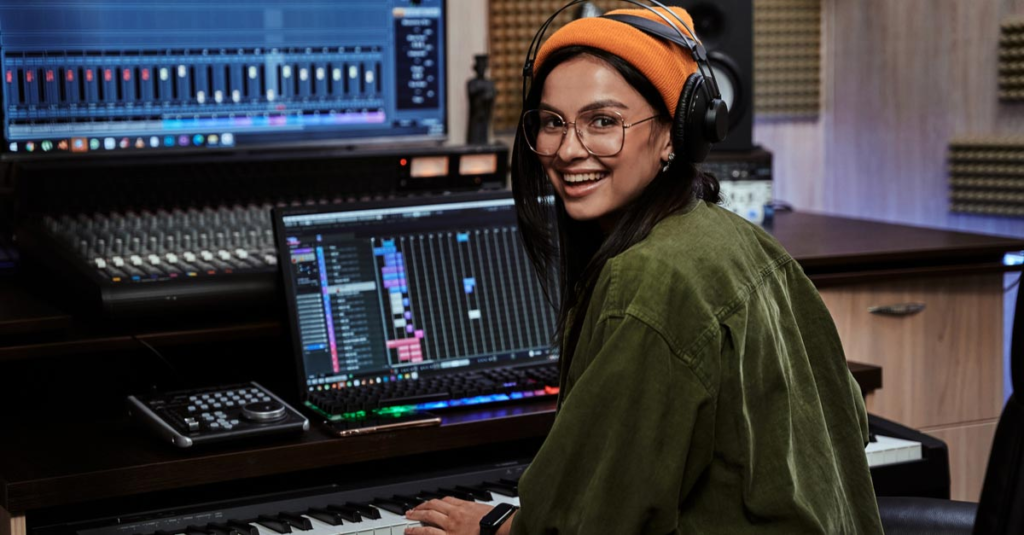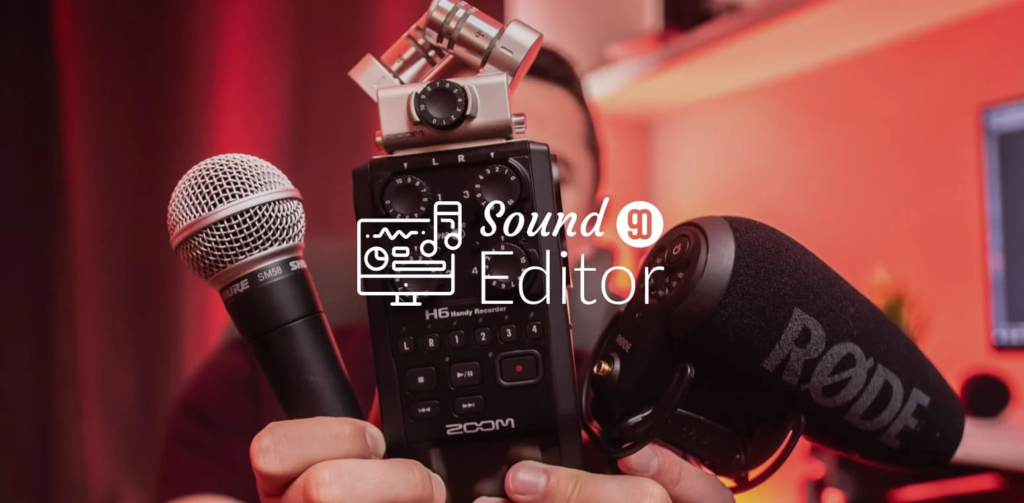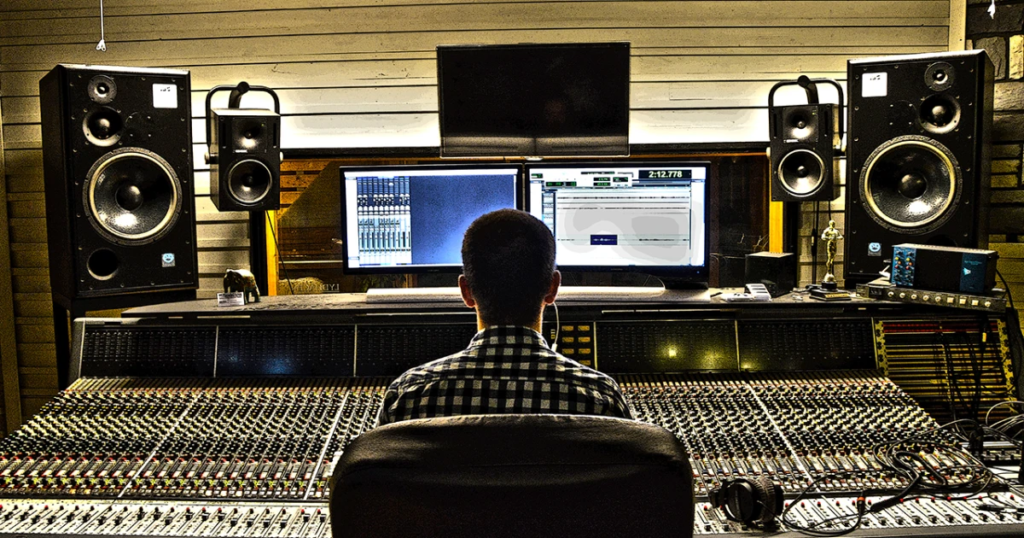Sound Editor (1 years diploma)
Sound Editor click here
Brief Job Description: Individuals at this job are responsible for preparing, organizing and
editing sound sequences that meet the quality standards and requirements of production.
Personal Attributes: This job requires the individual to know how to operate a range of
sound equipment and software. Depending on the size of the production, the individual may
have to delegate to/supervise several Sound
Editing Assistants or Sound Specialists. The
individual must be well-versed in the principles of acoustics, psychoacoustics and aural
discrimination. The individual must be able to select sound sources and apply various editing
techniques and treatments to create quality end-products that meet production
requirements.

Description
Acoustics Acoustics is the science of sound production, creation of effects and their
transmission
Budget Budget is an estimate of the total cost of production that may include a
break-up of cost components
Continuity Continuity represents the seamless transition from one shot to another
Copyright Laws A legal framework linked to intellectual property and the rights given to
creators of original products/ concepts
Creative Brief Creative brief is a document that captures the key questions that serve as
a guide for the production including the vision, objective of the project,
target audience, timelines, budgets, milestones, stakeholders etc.
Psychoacoustics Psychoacoustics is the study of the psychological and physiological
responses to sound.
Target Audience Group of people at whom content/ adverting is aimed. A target audience
is typically defined by age, gender, economic classification, geography and
any other relevant parameters (e.g. Females, aged 25-40, average monthly
household income INR 25,000-50,000, from Hindi speaking states in North
India)
Timelines Timelines is a listing of dates by which the production milestones/stages
need to be completed

Sector Sector is a conglomeration of different business operations having similar
businesses and interests. It may also be defined as a distinct subset of the
economy whose components share similar characteristics and interests.
Sound concept Sound concept is a description of the overall sound experience for the
production
Sub-sector Sub-sector is derived from a further breakdown based on the
characteristics and interests of its components.
Vertical Vertical may exist within a sub-sector representing different domain areas
or the client industries served by the industry.
Occupation Occupation is a set of job roles, which perform similar/related set of
functions in an industry
Function Function is an activity necessary for achieving the key purpose of the
sector, occupation, or area of work, which can be carried out by a person
or a group of persons. Functions are identified through functional analysis
and form the basis of OS.
Sub-functions Sub-functions are sub-activities essential to fulfill the achieving the
objectives of the function.
Job role Job role defines a unique set of functions that together form a unique
employment opportunity in an organization.
Occupational Standards
(OS)
OS specify the standards of performance an individual must achieve when
carrying out a function in the workplace, together with the knowledge and
understanding they need to meet that standard consistently. Occupational
Standards are applicable both in the Indian and global contexts.

Performance Criteria Performance Criteria are statements that together specify the standard of
performance required when carrying out a task
National Occupational
Standards (NOS)
NOS are Occupational Standards which apply uniquely in the Indian
context
Qualifications Pack For Sound Editor
Qualifications Pack
Code
Qualifications Pack Code is a unique reference code that identifies a
qualifications pack.
Qualifications Pack(QP) Qualifications Pack comprises the set of OS, together with the educational,
training and other criteria required to perform a job role. A Qualifications
Pack is assigned a unique qualification pack code.
Unit Code Unit Code is a unique identifier for an Occupational Standard, which is
denoted by an
Unit Title Unit Title gives a clear overall statement about what the incumbent should
be able to do.
Description Description gives a short summary of the unit content. This would be
helpful to anyone searching on a database to verify that this is the
appropriate OS they are looking for.
Scope Scope is the set of statements specifying the range of variables that an
individual may have to deal with in carrying out the function which have a
critical impact on the quality of performance required.
Knowledge and
Understanding
Knowledge and Understanding are statements which together specify the
technical, generic, professional and organizational specific knowledge that
an individual needs in order to perform to the required standard.
Organizational Context Organizational Context includes the way the organization is structured and
how it operates, including the extent of operative knowledge managers
have of their relevant areas of responsibility.
Technical Knowledge Technical Knowledge is the specific knowledge needed to accomplish
specific designated responsibilities.
Core Skills/Generic
Skills
Core Skills or Generic Skills are a group of skills that are key to learning and
working in today’s world. These skills are typically needed in any work
environment. In the context of the OS, these include communication
related skills that are applicable to most job roles.
Keywords /Terms Description
NOS National Occupational Standard(s)
QP

Qualifications Pack
NSQF National Skill Qualifications Framework
NVEQF National Vocational Education Qualifications Framework
NVQF National Vocational Qualifications Framework
Edit sound
Description This OS unit is about editing different sound sources in accordance with production
requirements
Scope This unit/task covers the following:
Edit various sound sources
(live or pre-recorded music, atmosphere tracks, dialogue, foley effects,
live/pre-recorded/electronic sound effects tracks; end-products could include
sound tracks, films, interviews, documentaries, news broadcasts, radio
programmes)
Performance Criteria (PC) w.r.t. the Scope
Element Performance Criteria
Edit various sound
sources
To be competent, the user/individual on the job must be able to:
PC1. identify/align/organise unedited sound materials, and check
sound equipment/editing facilities in preparation for editing
PC2. verify the technical/creative quality of sound sources and whether they meet
production standards, propose options to resolve issues as required
PC3. critically listen to sound sources to determine the extent and range of required
edits w.r.t. the format of the end-product
PC4. cut and synchronise the sound sources, removing any extraneous background
sounds in preparation for final sound mixing
PC5. manage the creative/technical quality check of the final sound edit in line with
enterprise procedures and production requirements
PC6. organise the digitisation and transfer of sound sources to appropriate
equipment, ensuring that the requirements for digital storage and formatting
are met
Knowledge and Understanding (K)
A. Organizational
Context
(Knowledge of the
company /
organization and
its processes)
The user/individual on the job needs to know and understand:
KA1. the technical and creative requirements of the sound edit, as agreed upon
during discussions with the director and producers
KA2. the end-use and likely output devices from which the sound would be heard
KA3. applicable timelines and budget for editing the required sound sequences
Technical
Knowledge
The user/individual on the job needs to know and understand:
KB1. industry-standard sound editing conventions, processes and techniques – both
analogue and digital

KB2. the principles of acoustics, psychoacoustics and aural discrimination, so as to
critically analyse sound elements/sequences
KB3. the principles of sonic storytelling, so as to focus attention, intensify action and
set the pace/mood
KB4. how to identify sound defects (e.g. muffled dialogue) and troubleshoot these
issues
KB5. how to digitise/change/back-up different sound materials w.r.t. file formats,
compression and technical standards
KB6. how to synchronise picture and sound using time codes, frame rates and
sample rates
KB7. the principles of sound recording, editing and mixing equipment
KB8. how to edit a range of audio sequences/segments using various sound
equipment/software (Avid, Adobe Audition, Magix Music Maker, Goldwave)
to achieve the technical/creative requirements of the production
KB9. THE APPLICABLE copyright norms and intellectual property rights
Skills (S) (Optional)
A. Core Skills/
Generic Skills
Writing Skills
The user/individual on the job needs to know and understand how to:
SA1. identify/ obtain, log, label, securely store and back-up sound materials
SA2. accurately note sound effects on spotting sheets
SA3. log/assess sound sequences and submit edit decision lists to relevant
production personnel by the agreed deadline
Reading Skills
The user/individual on the job needs to know and understand how to:
SA4. read and understand the creative and technical requirements for editing
SA5. read the script and understand the context/emotion that would need to be
expressed through editing
SA6. keep up-to-date knowledge of editing software and equipment upgrades
SA7. read and interpret sound documentation and edit decision lists
Oral Communication (Listening and Speaking skills)
The user/individual on the job needs to know and understand how to:
SA8. participate in pre-production meetings with relevant personnel to discuss the
creative/technical objectives of the sound edit, as well as post-production
spotting sessions to make the appropriate adjustments
SA9. communicate effectively with producers/director/relevant personnel
regarding the sound concept, as well as creative/technical requirements
SA10. collaborate with the sound designer, engineer to establish needs/
requirements throughout the production schedule and ensure that the final
product meets guidelines
SA11. provide feedback to junior personnel regarding editing techniques (optional),
and to equipment/IT personnel regarding editing equipment/software quality
SA12. present and solicit feedback on the end-products and identify modifications, if
required

B. Professional Skills Plan and Organize
The user/individual on the job needs to know and understand how to:
SB1. plan and delegate work (where required and as needed) so as to deliver the
end-products required within timelines and within the designated budget
Problem Solving
The user/individual on the job needs to know and understand how to:
SB2. identify problems with the successful execution of the task (e.g. sound defects,
system failures, mechanical breakdowns) and resolve them in consultation with
relevant personnel
Critical Thinking
The user/individual on the job needs to know and understand how to:
SB3. critically analyse the end-products to ensure they are of the optimum quality
and meet the requirements of post-production
Document and store media
Description This OS unit is about keeping accurate logs, labelling media, and sorting media
accurately and safely.
Scope This unit/task covers the following:
Storing media in appropriate conditions which will optimize the life of the
materials, and storing recordings safely and securely.
Performance Criteria (PC) w.r.t. the Scope
Element Performance Criteria
Storing media in
appropriate
conditions which will
optimize the life of
the materials, and
storing recordings
safely and securely
To be competent, the user/individual on the job must be able to:
PC1. keep an accurate, concise, legible and up-to-date log in the required format
PC2. keep a log which accurately and succinctly shows complete details of the
setup and selected takes, and indicates their quality and acceptability.
PC3. show, the correct title of production, the date when the material was created,
and any other relevant details on accurate and up-to-date labels
PC4. label the recorded medium clearly and confirm that the medium and its
container carry identical marks
PC5. safeguard materials for future use where commercially important
PC6. store recordings, back-up recordings and related materials securely and safely
Knowledge and Understanding (K)
A. Organizational
Context
(Knowledge of the
company /
organization and
its processes)
The user/individual on the job needs to know and understand:
KA1. the technical and creative requirements of the production and storage
requirements, as agreed upon during discussions with the director and
producers
KA2. the end-use and likely output devices from which the sound would be heard
KA3. applicable timeline/budget for storing required sound sequences
B. Technical
Knowledge
The user/individual on the job needs to know and understand:
KB1. standard labelling systems, electronic or paper, and which one is required for
the media
KB2. what types of media and associated materials are to be stored
KB3. any relevant or required metadata standards
KB4. the basics of sound recording, editing and mixing equipment
KB5. when it is necessary to log session details such as microphone position and desk
settings
KB6. what information is required on labels, the technical parameters and
synchronization information to be included on the documentation, and the
recording format as it should be noted in the log
KB7. how to log problems or other useful information
KB8. the anticipated deterioration times of the media being used, as specified by the
manufacturer, and how to replace archive material when necessary
KB9. the storage file and optimum storage conditions of the media and the effect of
adverse conditions on it
Skills (S) (Optional)
A. Core Skills/
Generic Skills
Writing Skills
The user/individual on the job needs to know and understand how to:
SA1. identify/ obtain, log, label, securely store and back-up sound materials
Reading Skills
The user/individual on the job needs to know and understand how to:
SA2. read and understand the creative and technical requirements for storage of
materials
SA3. keep up-to-date knowledge of storage techniques and equipment upgrades
Oral Communication (Listening and Speaking skills)
The user/individual on the job needs to know and understand how to:
SA4. communicate effectively with producers/director/relevant personnel on
possible uses of the documented/stored media
SA5. collaborate with the sound designer, engineer or supervisor to establish
requirements and ensure that guidelines are met
B. Professional Skills Plan and Organize
The user/individual on the job needs to know and understand how to:
SB1. plan and delegate work (where required and as needed) so as to
deliver the endproducts required within timelines and within the designated budget
Problem Solving
The user/individual on the job needs to know and understand how to:
SB2. identify problems with the successful execution of the task (e.g. sound defects,
system failures, mechanical breakdowns) and resolve them in consultation
with relevant personnel
Critical Thinking
The user/individual on the job needs to know and understand how to:
SB3. critically analyse the end-products to ensure they are of the optimum quality
and meet the requirements of post-production
Mix sound
Description This OS unit is about recording/mixing sound using different sound sources in
accordance to production requirements.
Across productions and sound sources such as: Productions could include sound tracks,
background scores, interviews, documentaries, live events, news broadcasts, radio
programmes; Sound sources can include live music, songs, interviews, announcements,
dialogues, commentaries etc., pre-recorded sound tracks/clips, phone-ins
Scope This unit/task covers the following task:
Work with sound sources
Mix sound
Work with contributors and colleagues
Performance Criteria (PC) w.r.t. the Scope
Element Performance Criteria
Work with sound

sources
To be competent, the user/individual on the job must be able to:
PC1. select valid criteria and use reliable methods to assess the sources required for
the final mix
PC2. confirm that sound sources have the desired intelligibility, position and image
in terms of the required sound
PC3. ensure that stereo and multi-channel sound sources have the required
compatibility, where appropriate
PC4. control the level of the composite signal within technical limits and within the
desired dynamic range
Mix Sound To be competent, the user/individual on the job must be able to:
PC5. manipulate sound sources to achieve the level, balance, tonal quality,
perspective and dynamic range appropriate to the required sound
PC6. create the sound mix within production constraints
PC7. create a sound mix which is appropriate to the context in which it will be heard
PC8. accurately identify and promptly correct any problems in creating the mix,
minimising disruption to contributors and colleagues
PC9. ensure that tracks and mixes are organised in a way that is suitable for later
use in editing
PC10. ensure that any paperwork is accurate, legible and conforms with conventions
that will be understood by other mixers, sound technicians etc.
Work with
Contributors and
Colleagues
To be competent, the user/individual on the job must be able to:
PC11. efficiently communicate with sound or other crew regarding equipment
positioning and requirements
PC12. respond to and interpret suggestions from the contributor, colleagues, client
or production during sound mixing, clarify any ambiguities or
misunderstandings, and take appropriate action
PC13. Explain clearly any problems with the sound mix, and offer realistic options
Knowledge and Understanding (K)
A. Organizational The user/individual on the job needs to know and understand:
KA1. the creative and technical requirements of the production/sound concept
KA2. the expected quality standards for the production
KA3. applicable timelines and budget for recording the required sound
B. Technical
Knowledge
The user/individual on the job needs to know and understand:
KB1. the functional and operating characteristics of commonly used mixing, ancillary
and encoding equipment
KB2. the principles of “storytelling” and the conventions of different genres and
styles of film and programme-making
KB3. the requirements for dynamic range and intelligibility, and how to achieve
them
KB4. the different kinds of sound treatment and equalisation, and how to achieve
them
KB5. the characteristics of tonal quality and perspective, and how to achieve them
KB6. basic principles of pitch, rhythm, melody, harmony and time signatures and
how to apply them
KB7. the characteristics, uses and requirements of mono, stereo and surround
formats, and how to achieve them
KB8. the principles and styles of music and different musical ensembles (orchestra,
string quartet, rock group, jazz quartet, soloist, etc.)
KB9. the context in which the mix will be played, what the end-product will be used
for and the equipment it will be heard through- and how to take this into
account when creating the mix
KB10. the needs of post-production sound and editing, and how the sound will be
used in postproduction
KB11. sound editing/mixing software (e.g.: adobe audition, nuendo, pyramix) w.r.t.
both their theoretical and practical components
KB12. the applicable copyright norms and intellectual property rights
Skills (S) (Optional)
A. Core Skills/
Generic Skills
Writing Skills
The user/individual on the job needs to know and understand how to:
SA1. prepare notes to use during the recording/mixing sessions
Reading Skills
The user/individual on the job needs to know and understand how to:
SA2. read and understand the sound concept
SA3. read and understand the creative and technical requirements for recording
SA4. read the script and understand the context/emotion that would need to be
expressed through the sound
Oral Communication (Listening and Speaking skills)
The user/individual on the job needs to know and understand how to:
SA5. communicate effectively with the sound supervisor, producers or contributors
regarding the sound concept, as well as creative/technical requirements








